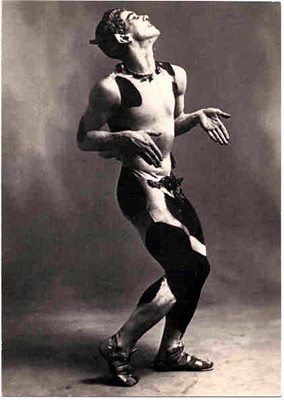
What made you weird?
For many of us there is an event, a circumstance or a series of both that altered us in a specific way, making us strange, odd, whatever you want to call it enough to seek lives less ordinary. It’s different for everyone – Nadya, for instance, was inspired in part by Janet Jackson’s Rhythm Nation video’s military look and overall stompiness. For there were several components and so I present you a partial list of What Made Me Weird.
My Parents

Let’s get this one out of the way. I’ll narrow this down to just a couple of things, though I have much to thank them for. They took time to expose me to theaters and museums since a very early age, despite the social state of ’80s Russia and our modest finances. I grew up surrounded by literature and read things like Spartacus and Dandelion Wine. With my parents’ busy schedules I was often left home alone to rummage through my mother’s numerous art books and my father’s hefty collection of science fiction. Soon I realized I preferred to spend time by myself, not making me the best candidate for schoolyard popularity.


Why Doesn’t Alt Culture Exist?

Yesterday, our friend Warren Ellis posed an interesting question: “why doesn’t alt culture exist?” In his weekly column, The Sunday Hangover, Warren points the finger in the same direction as our mission statement, blaming the rapacious mainstream. However, Warren goes a step further, fingering another culprit:
We’re in Reynolds’ “anachronesis” — living in a time of constant, delusional recursion, in a limbo of a dozen different pasts. Re-enactment, like living as a medieval soldier for a never-ending Renaissance Faire. Being Lenny Kravitz. Being the White Stripes. Record collection bands. People who like Amy Winehouse. Reynolds again: “Things under the sway of anachronesis are just nothing. You might as well be dead.”
Here’s another theory: perhaps anachronesis is not the retardant of a burgeoning alt culture, but its catalyst. After all, every subculture has always been a mediated response to the mainstream: punk culture’s rebellion grew out of a disillusionment with the rewards promised by white-collar mobility; Rastafarianism was a subversion of the white man’s religion; both the riot grrls of the 90s and the flappers of the 20s adopted certain styles to reject – or reclaim – certain conventions of womanhood. What, then, is the mainstream culture that today’s alt puts under the microscope?


Mondo 2000: Where Are they Now?

The last issue of Mondo 2000, featuring Nina Hagen on the cover.
I’m obsessed with dead magazines, especially ones that crossed over into the mainstream. The history of such magazines often sounds like a VH-1 Behind the Music special; first the group’s idealistic creation rises to fame on account of its originality, then comes the inevitable collapse due to in-fighting under the conflicting pressures of appeasing a wider audience, a set of advertisers and the project’s own artistic aims. More often then not, the problem is simply that such a magazine is way ahead of its time. This was the case with Mondo 2000, yet I’m grateful that it existed precisely when it did.
So, what made Mondo 2000 so special? It was, in my opinion, the best alternative culture magazine that America ever had. They wrote about smart drugs, brain implants, virtual reality, cyberpunk, Cthulhupunk and cryogenics. They covered Laibach and Lydia Lunch in the same issue. The pantheon of writers was a force to be reckoned with: Bruce Sterling, Robert Anton Wilson, and William Gibson all lent their talents, and there was even a Burroughs vs. Leary interview face-off. Then there was the famous U2-Negativland interview, in which Negativland, disguised as reporters, interviewed U2 into a corner to reveal the band’s hypocrisy over their lawsuit against Negativland over sampling. All in all, the magazine took risks. “The good dream for me and Mondo,” said editor R.U. Sirius in an interview with Purple Prose, “is overcoming the limits of biology without necessarily leaving sensuality or sexuality behind.” Issue after issue, Mondo 2000 threw a sexy dystopian bash and invited the decade’s best thinkers.


Suzanne G. Is Made of Awesome. And Squirrel Toes.
Thee High Priestess ov Thee Temple ov Psychick Blah (T.H.P.O.T.T.O.P.B.)*
And now it’s time for a joyous yodel (erm, sorry) shout out to a dear sister in Lucerne, Mlle Susanne G., a young lady who has officially been keeping it weird on the web since 2003. Unofficially? Much longer than that. In fact, we first found one another on deadjournal (of all the godforsaken places!) maaaany, many moons ago. Like, a moon in the nineties. *gasp*
Her blog compendium, Wurzeltod, is one of my absolute favorite nooks on the net, “a drawer full of all things weird, grotesque, bitter-sweet, embalmed and fortean. Brought to you by Suzanne – the eternal art history student.” You’ll laugh, you’ll cry… occasionally you’ll gag. It’s bliss.
So go for the gas masks, stay for the marzipan, and tell her Coilhouse sent ye.
*photo © of Suzanne G.

Vaslav Nijinsky’s diaries
Vaslav Nijinsky, originally uploaded by Coilhouse.
In recent days I’ve descended into a Vaslav Nijinsky vortex, my obsession with abnormal psychology drove me to find every bit of information i could. Easily one the most influential dancers and another brilliant creator whose genius turned to madness, his diaries are a keyhole glimpse into a fascinating mind detaching itself from the world.
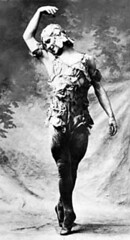
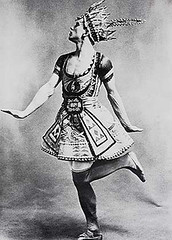
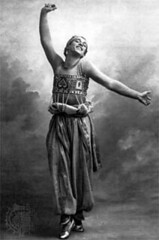
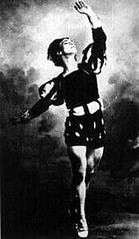
I retired into myself. I retired so deep into myself that I could not understand people. I know that everyone will suffer reading these lines, because I know that people will feel me. I’m a strong man, not a weak one. I’m not sick in the body. I feel a piercing stare from behind. I feel people want to harm me, but I will not fight and my enemy will be disarmed. They may wound me, but they will not kill me. I’m not afraid of suffering, because God will be with me. I know how to suffer.


The Flap of 1896-1897
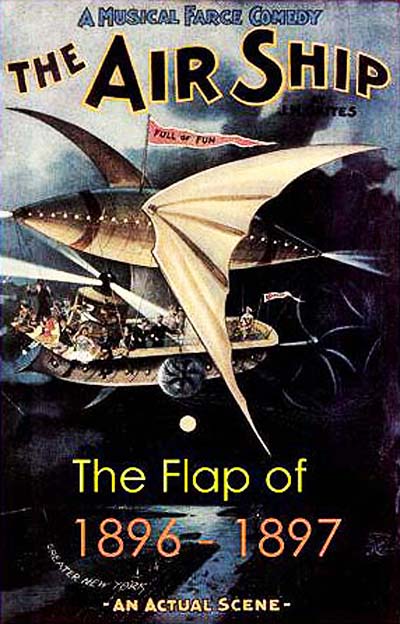
From late 1896 through early 1897, a full ten years before the flight of the first known powered dirigible, thousands of people across America claimed to see strange lights in the night sky, heard voices and music emanating from a mysterious airship. Some accounts described a cigar-shaped gasbag, others noted vast flapping canvas wings and large wheels like a paddle steamer’s. One early eye witness even insisted he’d glimpsed two men suspended in the ship’s undercarriage, furiously working bicycle pedals. From Sacramento to Chicago, folks from all walks of life strove to convince skeptical journalists that what they’d seen was not, in fact, an elaborate hoax.
The most carefully researched book written to date about the phenomenon is probably The Great Airship Mystery by Daniel Cohen. Cohen gives a well-rounded account of the circumstances and evidence before concluding –quite sensibly– that the airship probably never existed. (Bummer.)
Several other authors have offered up far more juicy theories. Michael Busby maintains in his own book Solving the 1879 Airship Mystery that a secret society of mad genius inventors joined forces to build a handful of highly advanced aircraft worthy of Jules Verne, each of which, after being viewed by countless drunken farmhands in the Midwest, inexplicably crashed and burned over the Atlantic ocean.
Noted ufologist/parapsychologist/journalist John Keel includes the sightings in the book UFOs: Operation Trojan Horse as compelling evidence for his long-standing hypothesis that certain “non-human or spiritual intelligence sources” have been staging elaborate events for centuries to manipulate and misinform the human pysche. (Other examples he cites include the fairy folklore of Middle Europe, vampire legends, black helicopter sightings, poltergeist phenomena and UFOs.)
Although the initial sightings in the US ended in 1897, several more sightings occurred in England, Europe and New Zealand from 1909 through 1913. In 1912, vaudeville superstars Elsie Baker and Billy Murray penned a little ditty about the airship fervor entitled “Mysterious Moon” and recorded it on wax cylinder.
A comprehensive list of newspaper clippings from 1897 newspapers can be found here. Wikipedia’s got a good entry on the subject as well.

Slap in the Face of Public Taste
“We order that the poets’ rights be revered:
- To enlarge the scope of the poet’s vocabulary with arbitrary and derivative words (Word-novelty).
- To feel an insurmountable hatred for the language existing before their time.
- To push with horror off their proud brow the Wreath of cheap fame that You have made from bathhouse switches.
- To stand on the rock of the word “we” amidst the sea of boos and outrage.
And if for the time being the filthy stigmas of your “common sense” and “good taste” are still present in our lines, troche these same lines for the first time already glimmer with the Summer Lightning of the New Coming Beauty of the Self-sufficient (self-centered) Word.”
— 1917 David Burliuk, salve Alexander Kruchenykh, Vladimir Mayakovsky and Victor Khlebnikov. From A Slap in the Face of Public Taste, one of the few non-Italian authored Futurist manifestos.






